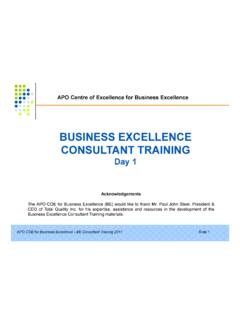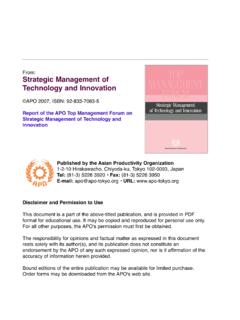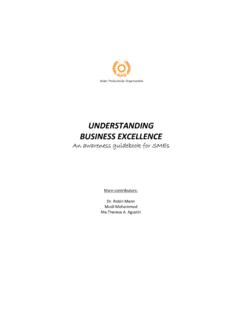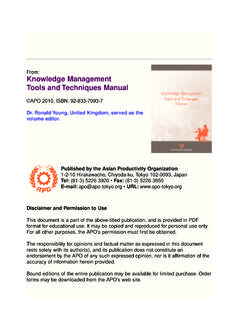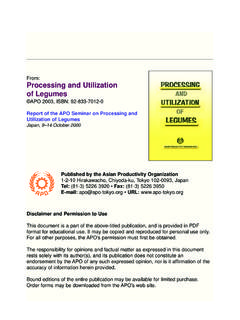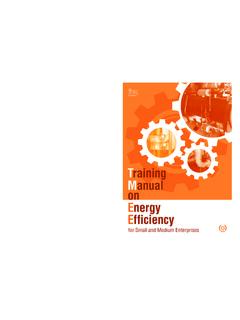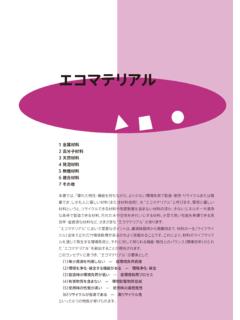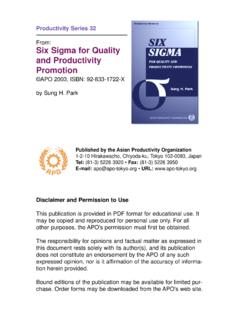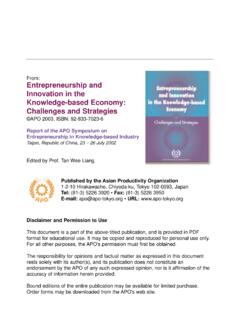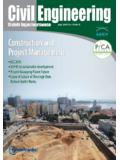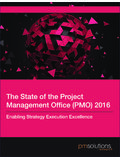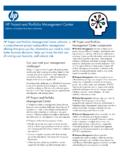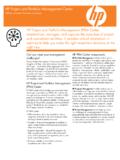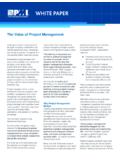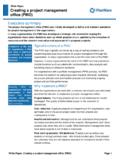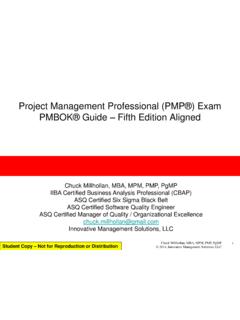Transcription of IMPLEMENTING BUSINESS EXCELLENCE - APO
1 IMPLEMENTING BUSINESS EXCELLENCE A A A A guideguideguideguidebookbookbookbook for SMEsfor SMEsfor SMEsfor SMEs Main contributors: Dr. Robin Mann Musli Mohammad Ma Theresa A. Agustin i TABLE OF CONTENTS Acknowledgements ii 1. Introduction 1 2. Core values and concepts of high performing organizations 2 3. Are you ready for BUSINESS EXCELLENCE ? 3 4. Deciding on which improvement initiatives to implement 6 5. Getting started IMPLEMENTING six improvement initiatives 9 Leadership: Vision, mission and values 9 Strategic planning: SWOT analysis 16 Customer focus: Self-assessment tool for developing a customer focused culture 18 Workforce focus: Suggestion scheme 22 Operations focus: PDCA cycle 28 Measurement, analysis and knowledge management: A personal performance measurement system 31 6: Undertaking a BUSINESS EXCELLENCE assessment 35 - Step 1: Understand organizational profile 36 - Step 2: Assess current performance 36 - Step 3: Identify area for improvement and set improvement goal(s) 39 - Step 4: Develop an action plan 41 - Step 5: Implement actions 41 - Step 6: Monitor progress and evaluate performance 42 - Step 7.
2 Continuously improve organizational performance 42 7. Further information 43 8. About the contributors 44 ii ACKNOWLEDGEMENTS We would like to express our appreciation to the numerous people who have contributed towards the completion of this booklet: Mr. Sherman Loo, Director, Administration and Finance Department, Asian Productivity Organization (APO). Mr. Darshan Singh, Director, BUSINESS & Service EXCELLENCE , Standards Productivity and Innovation Board Singapore (SPRING Singapore). Ms. Sam Choon Yuen, Senior Manager, BUSINESS & Services EXCELLENCE , SPRING Singapore Mr. Koh Sing Ming, Managing Consultant, Spectrum Management Consulting, Singapore Mrs. Waila Mohd Nasir, Consultant, Malaysia Productivity Corporation (MPC) Mr. Sivasena Seresena, Consultant, Malaysia Productivity Corporation (MPC) Mr.
3 Zainudin Elias, Director, Southern Region Office, Malaysia Productivity Corporation (MPC) Ms. Waleeporn Thanathikom, Senior Consultant, Thailand Productivity Institute Mr. Hsieh-Li Kung, Consultant, China Productivity Center, Republic of China Thanks to Steve George, for allowing us to use excerpts from the Baldrige Edge Secure your job .. Make it better .. Advance your career for the performance measurement section of the report. 1 1. INTRODUCTION This guidebook provides some simple steps and tools to help your organization to quickly improve its BUSINESS capability and performance. This guidebook is a continuation from the first guidebook titled Understanding BUSINESS EXCELLENCE : An Awareness Guidebook for SMEs . Figure 1: What can be achieved through the application of BUSINESS EXCELLENCE ?
4 Figure 1 above, based on the mapping of revenue of BUSINESS EXCELLENCE award winners, shows that revenue can be substantially increased through the application of BUSINESS EXCELLENCE . Is this something your organization desires? THOUGHT The BUSINESS EXCELLENCE framework is the the BUSINESS EXCELLENCE categories address everything ( leadership, planning, processes, people, customers, results) that is important for sustainability Mr. Harnek Singh Vice President and Director of BUSINESS EXCELLENCE Singapore Technologies Engineering Ltd The first recipient of the Singapore Quality Award with Special Commendation in 2007 Source: Insight to BUSINESS EXCELLENCE , SPRING Singapore 2 2. CORE VALUES AND CONCEPTS OF HIGH PERFORMING ORGANIZATIONS There are eleven widely recognized embedded beliefs and behaviours found in high performing organizations - otherwise known as the Core Values and Concepts of BUSINESS EXCELLENCE 1.
5 These are: Visionary leadership Customer-driven EXCELLENCE Organizational and personal learning Valuing workforce members and partners Agility Focus on the future Managing for innovation Management by fact Societal responsibility Focus on results and creating value Systems perspective The core values and concepts are embodied in BUSINESS EXCELLENCE models such as the Baldrige Criteria for Performance EXCELLENCE (see Figure 2). These models are used to assess how well the core values and concepts are integrated into an organization s systems and processes. As shown in Figure 2, the Baldrige model is composed of seven categories. Six of these, labeled 1 to 6, are called the Process categories and the other is called the Results category. The Process categories show what an organization does and the Results category shows what an organization achieves.
6 Figure 2: 2011-2012 Baldrige Criteria for Performance EXCELLENCE model 1 For further information about the BE core values and concepts, please refer to the following APO s booklet: Understanding BUSINESS EXCELLENCE : An awareness guidebook for SMEs . 3 3. ARE YOU READY FOR BUSINESS EXCELLENCE ? Is your organization ready for BUSINESS EXCELLENCE ? It is often difficult to obtain 100% commitment to new initiatives BUSINESS EXCELLENCE is no different. Complete the following self-assessment to assess your organization s readiness for BUSINESS EXCELLENCE (see Figure 3). Indicate with a tick( ) your level of agreement with the statements below Highly Disagree Disagree Agree Highly Agree Action (if disagree or highly disagree) INITIATING CHANGE Leading Change We have designated senior leaders who will champion BUSINESS EXCELLENCE (BE).
7 Our senior leaders will provide the time, passion, and focus needed to start the BE journey. Our CEO is fully supportive and ready to lead the BE journey by example. Creating a Shared Need We have spoken to BE organizations and our local BE administrative body on how to start the BE journey. Our senior managers can explain the 'reason' for BE and why they support the need for change. Our senior managers fully understand what is BE and their role to make it happen. IMPLEMENTATION Implementation Readiness We have a clear plan on how to embed the Core Values and Concepts of BE into our organization. We have identified our training needs and considered BE self-assessments as part of the implementation plan. SUSTAINING CHANGE Making Change Last All our senior management team are going to be held accountable for IMPLEMENTING at least some part of the BE plan.
8 We have meaningful indicators and assessment methods in place to assess our organization s progress in BE Figure 3: Are you ready for BUSINESS EXCELLENCE ? 4 If your organization disagrees or highly disagrees with a statement then consider how you can improve your score. Here are some potential actions that you may wish to undertake: Leading Change There should be an intensive executive briefing on the significance and relevance of BE to organizational performance. There has to be a buy-in by senior leaders to make it a reality in the organization. Make each senior leader responsible for improving performance in one category of BE ( leadership, strategic planning, customer focus, measurement, analysis and knowledge management, workforce focus and operations focus). Ensure senior leaders organize and lead regular meetings to focus on how systems and performance can be improved.
9 Get the CEO to deliver a short presentation on the importance of BE at all improvement related training sessions. Creating a Shared Need Find out which organizations in your local area have won a BE award and arrange a visit to learn from them. Conduct a teambuilding session with an emphasis on visioning, , to project what the organization wants to achieve within a particular period of time - for example 3-5 years from now. Project what the organization can achieve with and without BE in place. Organize meetings to discuss BE and what it means for each person, department and the organization as a whole. Give all senior managers a copy of the APO s booklet titled Understanding BUSINESS EXCELLENCE : An awareness guide for SMEs . Implementation Readiness Have a brainstorming meeting and consider whether the core values and concepts are relevant to your organization and, if so, what needs to be done to embed them.
10 Ensure that your self-assessment process (which identifies your organization s strengths and opportunities for improvement) and action-planning process have been planned and include a large proportion of your organization s stakeholders (senior managers, middle managers, employees and customers and suppliers as necessary). This will lead to greater buy-in of BUSINESS EXCELLENCE . Making Change Last Recognize and reward senior managers and project teams that are successful with BE projects. Celebrate success with thank you notes, team dinners, and bonding activities. 5 Track all projects and actions that stem from the BE journey. Most importantly record all costs/ benefits per action or project, collate these together and share the information with all staff. Create and designate a BE corner in one of the conspicuous areas in the office with bulletin boards of information and graphs showing the results achieved.
